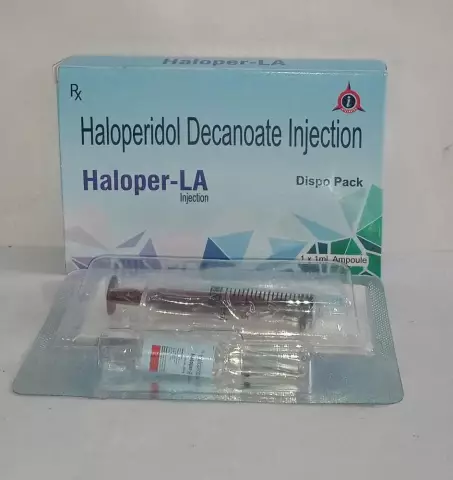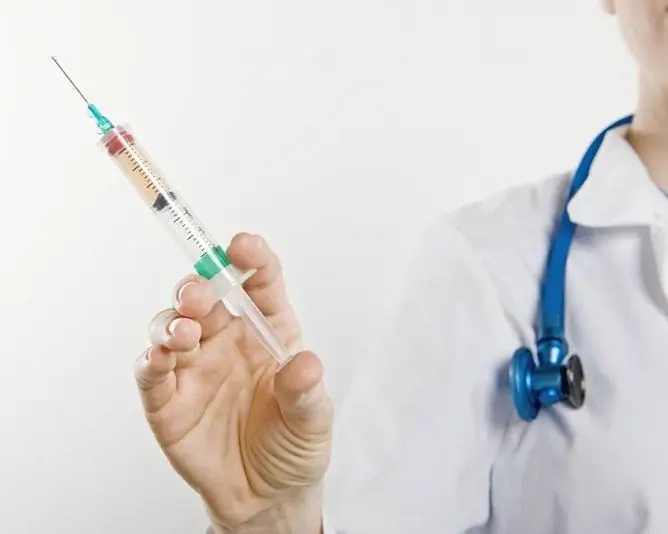- Author Rachel Wainwright [email protected].
- Public 2023-12-15 07:39.
- Last modified 2025-11-02 20:14.
Haloperidol Decanoate
Haloperidol decanoate: instructions for use and reviews
- 1. Release form and composition
- 2. Pharmacological properties
- 3. Indications for use
- 4. Contraindications
- 5. Method of application and dosage
- 6. Side effects
- 7. Overdose
- 8. Special instructions
- 9. Application during pregnancy and lactation
- 10. Use in childhood
- 11. In case of impaired renal function
- 12. For violations of liver function
- 13. Use in the elderly
- 14. Drug interactions
- 15. Analogs
- 16. Terms and conditions of storage
- 17. Terms of dispensing from pharmacies
- 18. Reviews
- 19. Price in pharmacies
Latin name: Haloperidol decanoate
ATX code: N05AD01
Active ingredient: haloperidol (Haloperidol)
Manufacturer: Gedeon Richter (Hungary)
Description and photo updated: 30.11.2018
Prices in pharmacies: from 295 rubles.
Buy

Haloperidol decanoate is a neuroleptic, antipsychotic drug.
Release form and composition
The drug is available in the form of an oily solution for intramuscular (i / m) administration: a clear greenish-yellow or yellow liquid (1 ml each in dark glass ampoules; 5 ampoules each in plastic trays, 1 pallet in a cardboard box and instructions for use Haloperidol decanoate).
1 ml of solution contains:
- active substance: haloperidol decanoate - 70.52 mg, which is equivalent to 50 mg of haloperidol;
- auxiliary components: sesame oil, benzyl alcohol.
Pharmacological properties
Pharmacodynamics
Haloperidol decanoate is a strong antipsychotic, butyrophenone derivative, a long-acting antipsychotic drug. Its active substance is an ester of decanoic acid and haloperidol, which is a pronounced antagonist of central dopamine receptors. After administration, haloperidol is released by slow hydrolysis and enters the systemic circulation.
Due to the direct blockade of central dopamine receptors in the treatment of hallucinations and delusions, haloperidol is highly effective. This is thought to be due to its action on the mesocortical and limbic structures. It has a pronounced calming effect in psychomotor agitation, mania and other agitations.
The activity of the drug in relation to the limbic system is manifested in a sedative effect. Haloperidol is indicated as an adjunct in patients with chronic pain.
The substance acts on the basal ganglia, causing extrapyramidal reactions in the form of dystonia, akathisia, parkinsonism.
In disorders characterized by social withdrawal, after taking Haloperidol decanoate in patients, normalization of social behavior is observed.
The pronounced anti-dopamine activity has an irritating effect on chemoreceptors, causing the development of nausea and vomiting. In addition, it is accompanied by relaxation of the gastroduodenal sphincter, blocks the prolactin-inhibiting factor in the adenohypophysis, which leads to an increased release of prolactin.
Pharmacokinetics
After i / m injection, the maximum concentration (Cmax) of haloperidol is reached after 3-9 days. In plasma, the saturation stage occurs against the background of monthly administration after 2-4 injections. Pharmacokinetics is dose-dependent, with doses below 450 mg, there is a direct relationship between plasma concentration and dose. The therapeutic effect occurs after a plasma concentration of haloperidol of 20-25 μg / L is reached.
Plasma protein binding - 92%.
Haloperidol easily crosses the blood-brain barrier (BBB) and is excreted in breast milk.
The half-life (T 1/2) is approximately 21 days. Up to 60% of the introduced substance is excreted through the intestine, 40% through the kidneys, of which about 1% is unchanged.
Indications for use
- psychoses, including chronic schizophrenia, especially in patients with a positive response to therapy with fast-acting haloperidol, who are indicated for the appointment of an effective neuroleptic with a moderate sedative effect;
- disorders of mental activity and behavior, accompanied by psychomotor agitation, which require long-term treatment.
Contraindications
Absolute:
- coma of various origins;
- oppression of the central nervous system (CNS), which has arisen against the background of taking medications or drinking alcohol;
- Parkinson's disease, other diseases of the central nervous system, which are accompanied by pyramidal or extrapyramidal symptoms;
- defeat of the basal ganglia;
- depression, hysteria;
- period of pregnancy;
- breast-feeding;
- childhood;
- hypersensitivity to drug components.
With caution, Haloperidol decanoate should be prescribed for epilepsy, decompensated diseases of the cardiovascular system (including angina pectoris, prolongation of the QT interval, intracardiac conduction disturbances, hypokalemia, or concomitant drug therapy that can contribute to a prolongation of the QT interval), angle-closure glaucoma, hepatic insufficiency (with symptoms of thyrotoxicosis), renal failure, prostatic hyperplasia with urinary retention, pulmonary heart and respiratory failure (including chronic obstructive pulmonary disease, acute infectious diseases), alcoholism.
During pregnancy, Haloperidol decanoate may be prescribed only in cases where the expected therapeutic effect for the mother outweighs the potential threat to the fetus.
Haloperidol decanoate, instructions for use: method and dosage
Haloperidol decanoate is an oily solution, therefore its intravenous administration is categorically contraindicated.
The solution is intended for parenteral administration by deep intramuscular injection into the gluteal region.
It should be borne in mind that the introduction of a solution in a dose exceeding 3 ml is accompanied by an unpleasant feeling of distention at the injection site.
When prescribing the initial dose of Haloperidol decanoate, the symptomatology of the disease, its severity, and the previous dose of haloperidol or other antipsychotics are taken into account.
The dose must be selected individually under strict medical supervision of the patient, because of the significant differences in responses to treatment in different patients.
Recommended dosage: the initial dose is 0.5-1.5 ml, which corresponds to 25-75 mg of haloperidol, once every 28 days. The initial dose of haloperidol decanoate should be 10-15 times higher than oral haloperidol, but should not exceed 100 mg. Based on the effect, the initial dose can be increased in 50 mg increments until the desired optimal effect is obtained. The maintenance single dose is usually 20 daily doses of oral haloperidol. If during the dose selection period the symptoms of the underlying disease recur, treatment can be supplemented with oral forms.
If necessary, taking into account the individual characteristics of the effect of the drug, more frequent intramuscular injection of the solution is possible (1 time in 14 days).
For patients with oligophrenia and patients in old age, the initial dose should be from 12.5 to 25 mg of the drug once every 28 days. The dose is increased depending on the individual response to therapy.
Side effects
- from the nervous system: drowsiness or insomnia (especially at the beginning of therapy), fears, anxiety, agitation, anxiety, headache, akathisia, depression, euphoria, epileptic seizures, lethargy, paradoxical reactions - hallucinations and exacerbation of psychosis; against the background of long-term treatment - extrapyramidal disorders, including tardive dyskinesia (puckering of the lips, smacking, puffing out of the cheeks, worm-like rapid movements of the tongue, uncontrolled chewing movements, movements of the arms and legs), tardive dystonia (spasms of the eyelids, rapid blinking, unusual facial expression or position body, bending uncontrollable movements of the neck, arms, trunk and legs), neuroleptic malignant syndrome [rapid or difficult breathing, increased or decreased blood pressure (BP), hyperthermia, increased sweating, tachycardia, arrhythmia,muscle stiffness, urinary incontinence, loss of consciousness, epileptic seizures];
- on the part of the cardiovascular system: against the background of the use of high doses - lowering blood pressure, arrhythmias, tachycardia, orthostatic hypotension, signs of flutter and fibrillation of the ventricles, prolongation of the QT interval;
- from the digestive system: against the background of the use of high doses - dry mouth, decreased appetite, nausea, vomiting, hyposalivation, diarrhea or constipation, functional liver disorders, including the development of jaundice;
- from the hematopoietic system: rarely - agranulocytosis, transient leukocytosis or leukopenia, a tendency to monocytosis, erythropenia;
- from the urinary system: peripheral edema, with prostatic hyperplasia - urinary retention;
- from the reproductive system and the mammary gland: menstrual irregularities, pain in the mammary glands, hyperprolactinemia, gynecomastia, increased libido, decreased potency, priapism;
- on the part of the organ of vision: blurred vision, cataract, retinopathy;
- from the side of metabolism: hyponatremia, hyperglycemia, hypoglycemia;
- dermatological reactions: maculopapular rash, acne, photosensitivity;
- allergic reactions: rarely - laryngospasm, bronchospasm;
- local reactions: possibly - the development of adverse events associated with the introduction of Haloperidol decanoate;
- others: weight gain, alopecia.
Overdose
An overdose of haloperidol is manifested by a significant severity of the established pharmacological side effects with the development of adverse reactions. The most dangerous symptoms include a decrease in blood pressure, extrapyramidal reactions in the form of a general or localized tremor and muscle stiffness, sedation, and sometimes a coma with arterial hypotension and respiratory depression, turning into shock. There is a risk of lengthening the QT interval, leading to the development of ventricular arrhythmias.
Treatment: there is no specific antidote. When treating a suspected overdose, it should be borne in mind that Haloperidol decanoate has a long-term effect. To ensure airway patency, it is necessary to use an oropharyngeal or endotracheal probe, with severe respiratory depression, artificial ventilation is performed. It is necessary to ensure careful observation of the patient's condition, monitoring of vital functions and electrocardiogram (ECG). Antiarrhythmic therapy is continued until the ECG is completely normalized. In the case of low blood pressure and circulatory arrest, the use of concentrated albumin and norepinephrine or dopamine, intravenous administration of fluid, plasma is recommended as vasopressor agents. With the development of severe extrapyramidal symptoms, regular administration of antiparkinsonian drugs with anticholinergic action is required for several weeks. It should be borne in mind that after the abolition of these drugs, extrapyramidal symptoms may resume.
The use of epinephrine is contraindicated. Its interaction with haloperidol can cause a significant increase in blood pressure and require immediate dose adjustment.
special instructions
Injections Haloperidol decanoate should be started after a positive response to prior therapy with oral haloperidol, this will reduce the risk of unexpected adverse reactions.
On the background of the use of antipsychotic drugs in psychiatric patients, episodes of sudden death were observed in rare cases.
Long-term therapy must be accompanied by regular examinations to monitor the blood picture and liver function.
Due to the risk of seizures in patients, epilepsy, head trauma, alcohol withdrawal or other conditions that lead to seizures, special care is required.
The use of Haloperidol decanoate in patients with hyperthyroidism is allowed only against the background of concomitant appropriate thyrostatic therapy.
Shown in combination with antidepressants in the treatment of patients with depression and psychosis or with the dominance of depression.
With concomitant antiparkinsonian therapy after discontinuation of the drug Haloperidol decanoate, it is recommended to continue it for several weeks due to the more rapid elimination of antiparkinsonian drugs. Haloperidol should be discontinued gradually to prevent withdrawal symptoms.
Against the background of initial therapy or the use of high doses of the drug, a sedative effect with a decrease in attention is possible. The severity of the sedative effect of Haloperidol decanoate can aggravate the use of alcohol, therefore it is forbidden to take alcoholic beverages during the treatment period.
During treatment, it is recommended to avoid heavy physical exertion and not take hot baths, since heatstroke may occur due to inhibition in the hypothalamus of central and peripheral thermoregulation.
Due to the increased risk of photosensitivity, it is necessary to refrain from exposure to direct sunlight with unprotected skin areas.
Cold medicines should not be taken without consulting a doctor, as they can increase the anticholinergic effect, which increases the risk of heatstroke.
Influence on the ability to drive vehicles and complex mechanisms
At the beginning of the injection use of Haloperidol Decanoate solution, patients are prohibited from driving and performing any activities that require increased concentration of attention and / or are associated with a high risk of injury.
Application during pregnancy and lactation
It is contraindicated to administer Haloperidol decanoate during gestation and lactation.
During pregnancy, it is allowed to prescribe the drug only in cases where the intended therapeutic effect for the mother exceeds the potential threat to the fetus.
The use of Haloperidol decanoate during lactation causes the development of extrapyramidal symptoms in infants. If it is necessary to prescribe therapy with the mother's drug, breastfeeding is recommended to be discontinued.
Pediatric use
The use of haloperidol for the treatment of children is contraindicated.
With impaired renal function
Haloperidol decanoate should be used with caution in patients with renal insufficiency.
For violations of liver function
With extreme caution, injections of Haloperidol decanoate should be prescribed to patients with hepatic insufficiency, since its metabolism is carried out in the liver.
Use in the elderly
The starting dose for elderly patients should be 12.5-25 mg of haloperidol every 28 days. The dose should be increased gradually, taking into account the individual response to the therapy.
Drug interactions
- tricyclic antidepressants, ethanol, opioid analgesics, sleeping pills, barbiturates, agents for general anesthesia: the severity of their depressing effect on the central nervous system increases;
- peripheral m-anticholinergics, antihypertensive drugs: the effect of most antihypertensive drugs and peripheral m-anticholinergics is enhanced;
- tricyclic antidepressants, monoamine oxidase inhibitors: the metabolism of these drugs slows down, there is a simultaneous increase in the sedative effect and toxicity of these drugs and haloperidol;
- bupropion: the risk of significant epileptic seizures increases with a decrease in the epileptic threshold of bupropion;
- anticonvulsants: haloperidol causes a decrease in the seizure threshold, reducing their effectiveness;
- dopamine, ephedrine, epinephrine, phenylephrine, norepinephrine: the vasoconstrictor effect of these drugs is weakened; a paradoxical decrease in blood pressure is possible when haloperidol is combined with epinephrine;
- antiparkinsonian drugs: Haloperidol decanoate clinically significantly reduces their effectiveness;
- anticoagulants: it is possible to increase or decrease their therapeutic effect;
- bromocriptine: due to a decrease in the effect of bromocriptine, a dose adjustment may be required;
- methyldopa: in patients taking methyldopa, the risk of disorientation in space, slowing down or difficulty in thinking processes, and the development of other mental disorders increases;
- amphetamines: there is a decrease in the psychostimulating effect of amphetamines and the antipsychotic effect of haloperidol;
- lithium preparations: it is possible to increase extrapyramidal symptoms, the development of irreversible neurointoxication (encephalopathy), especially with high doses of lithium;
- anticholinergic, antiparkinsonian, antihistamines (first generation) drugs: interactions with these drugs may increase the m-anticholinergic effect of haloperidol, reducing its antipsychotic activity. In this case, consideration should be given to the need for dose adjustment of Haloperidol decanoate;
- carbamazepine, barbiturates: against the background of long-term therapy with inducers of microsomal oxidation, the concentration of haloperidol in plasma decreases;
- fluoxetine: the likelihood of developing extrapyramidal reactions and other side effects from the central nervous system increases when haloperidol is combined with fluoxetine;
- drugs that cause extrapyramidal reactions: the frequency and severity of extrapyramidal disorders increases;
- tea, coffee: it should be borne in mind that the use of these drinks helps to reduce the therapeutic effect of haloperidol.
Analogs
Haloperidol decanoate analogs are Haloperidol, Haloperidol-Richter, Haloperidol-ratiopharm, Senorm, Benperidol, Melperon, Galomond, Halopril, etc.
Terms and conditions of storage
Keep out of the reach of children.
Store at temperatures up to 25 ° C in a dark place.
The shelf life is 5 years.
Terms of dispensing from pharmacies
Dispensed by prescription.
Reviews about Haloperidol Decanoate
Reviews of Haloperidol Decanoate are moderately positive. Patients in whom therapy with the oral form of haloperidol gave a positive response and showed good tolerability of the drug, when prescribing haloperidol in the form of i / m injections, did not notice the appearance of new serious negative effects. The advantages of the solution also include the dosage regimen.
Price for Haloperidol decanoate in pharmacies
The price of Haloperidol decanoate for a package containing 5 ampoules can range from 350 rubles.
Haloperidol decanoate: prices in online pharmacies
|
Drug name Price Pharmacy |
|
Haloperidol decanoate 50 mg / ml solution for intramuscular administration (oily) 1 ml 5 pcs. 295 RUB Buy |

Anna Kozlova Medical journalist About the author
Education: Rostov State Medical University, specialty "General Medicine".
Information about the drug is generalized, provided for informational purposes only and does not replace the official instructions. Self-medication is hazardous to health!






